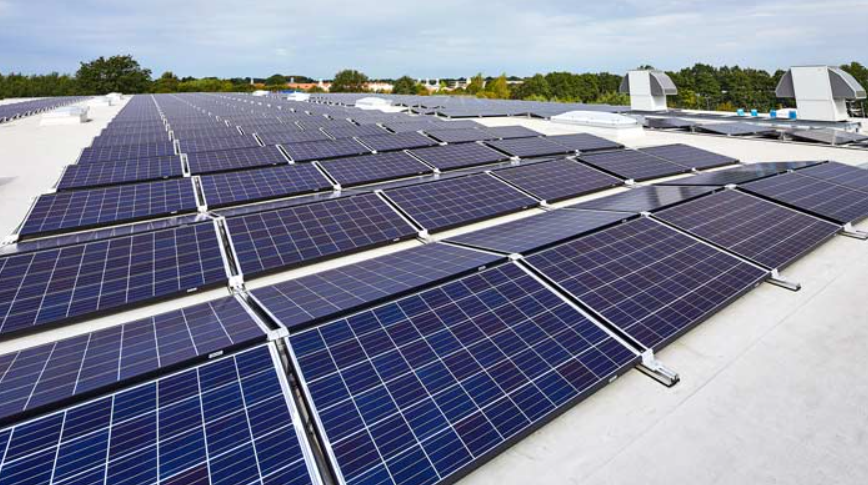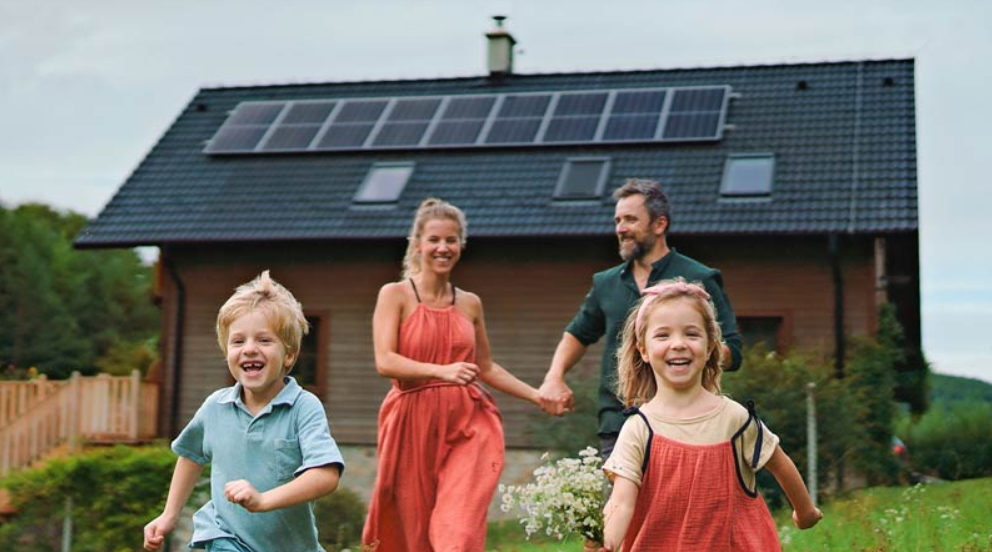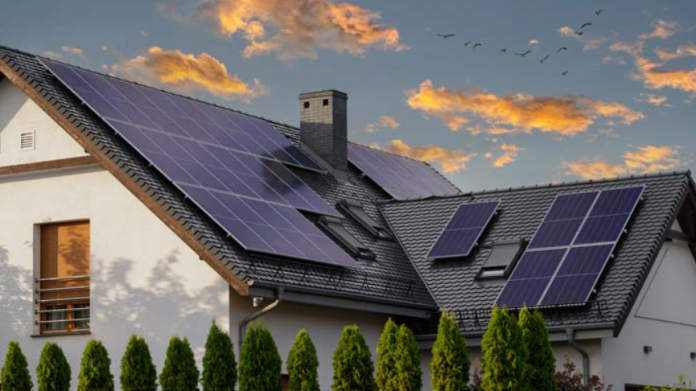Photovoltaic roofs enable environmentally friendly energy generation directly on your house or other buildings. In this article, you will learn everything you need to know about the required roof area, different types of installation, costs, funding options, and alternative application areas.
Which roofs are suitable for photovoltaics?
The house roof has many shapes, colors, types, and characteristics. Almost all roofs are suitable for the operation of a photovoltaic system.
Depending on the type of roof, specific mounting systems are used so that the PV modules can be properly attached to the roof.
Photovoltaic system: pitched roof and flat roof
A rough subdivision of the roofing can be made in pitched and flat roofs.
The sloping roof, also known as a pitched roof, includes various shapes with a roof pitch of 10 to 70 degrees.
The steep PV roof has been used en masse for power generation since the beginning of the 21st century and is considered a mature technology.
The solar modules of a pitched roof photovoltaic system are mounted parallel, lying flat on the roof. This makes the best possible use of the roof area, which is considered advantageous.
In addition, the typical roof pitch of 30 to 45° results in two advantages for the system operator of the photovoltaic roof:
In Germany, Austria, and Switzerland, the solar yield (800-1000 kWh/kWp) is high enough to make photovoltaic systems worthwhile.
The modules stay clean due to the self-cleaning effect of rain.
Flat roofs have no or minimal roof pitch of a maximum of 5 degrees, which means this type of Roof has some special features. When installed on a flat roof, solar panels are elevated using a metal frame, which improves the angle of inclination.
The special flat roof substructure is a little more expensive than a pitched roof, but the time-saving installation makes up for the price of a complete PV system.
Therefore, photovoltaic systems on a flat roof are well-suited for homeowners.
Suitable roof shapes for solar modules
Almost any roof shape can be used for photovoltaics. Common roof shapes, such as the gable roof, the hipped roof, or the pent roof, are well suited for attaching solar modules.
Normally only one side of the roof is covered with modules. If the gable roof is oriented east-west, it is also worth using it on both sides, as this leads to a higher nominal output and more even power generation throughout the day.
The PV system on the hipped roof is often even installed on three sides of the roof. Leisure batteries are also an essential part of a solar system, allowing you to store electricity for use at night.

Which roof covering is worthwhile for photovoltaics?
Conventional roof coverings such as clay roof tiles, concrete roof tiles, slates, metal (zinc, copper, steel, aluminum), and bitumen are well suited for use as PV roofs.
Even a green roof and solar system are possible with special mounting systems. Even the thatched or thatched roof can be equipped with PV modules under certain circumstances.
Prerequisites for the house roof to enable photovoltaics
For photovoltaics to be possible on the roof, the roof truss should be able to bear the weight of the PV system. It is necessary to ensure that the residual load-bearing capacity of the roof is high enough, considering additional wind suction and snow loads.
An average PV system on a house roof weighs around 11 to 15 kg per m². The highest weight is mainly due to the modules weighing 20 to 22 kg. Modern glass-glass modules weigh around 2 kg more due to the additional protective pane on the back.
The average service life of a PV system is 30 to 40 years. A normal tiled roof, on the other hand, lasts 50 to 60 years. The remaining durability of the roof construction and covering should be considered when planning the photovoltaic system.
A roof renovation requires the dismantling of the entire photovoltaic roof. This should be avoided to save cost and effort. Photovoltaics on an old roof is not recommended. If the remaining life of the house roof is only a few years, it should first be replaced.
The roof’s orientation has a major impact on the annual result of the solar system. The better the roof surface is aligned, the higher the PV yield over the day.

But what is the optimal orientation for a photovoltaic system?
The best roof orientation in the northern hemisphere is exactly south. Depending on other factors, the south orientation annually brings 900 to 1100 kWh per kW of installed PV capacity. Compared to a south-roof system, the specific yield of an east-west PV system is 15 to 25% lower. Both sides of the roof can easily be equipped with solar modules, which means that, in absolute terms, more electricity can be produced by the PV system.
A slight deviation from the south, a roof orientation to the southwest, only results in minimal yield losses of 5 to 8%.
In addition to the alignment, the pitch of the roof also plays a crucial role because the solar radiation should hit the module surface as vertically as possible to achieve the maximum output per square meter.
However, the sun moves throughout the day and takes up different positions in the sky. In addition, the sun’s position also changes with the season: in summer, the sun is very high in the sky, and in winter, it is rather flat, which means that the elevation angle fluctuates greatly.
Therefore, the best average roof pitch over the year is required for a particularly good yield from the solar system on the roof.
The ideal roof pitch for PV systems in Germany or Austria is 35°. On the other hand, only minimal performance losses are to be expected at inclines between 25 and 45 degrees.
I recommend looking at this PV roof pitch table to understand the interaction between orientation and pitch angle.
The geographical location influences the energy production of a photovoltaic system.
The more south the system is installed to the equator, the higher the yield. This is due to the regionally different global radiation, which decreases with increasing degrees of latitude.
The further north the PV array is, the lower the sun’s position, resulting in greater atmospheric absorption and scattering.
In other words, the further north the PV roof is positioned, the longer the sun’s rays travel through the atmosphere. Therefore, solar modules in southern Germany deliver about 10 percent more yield than in northern Germany.
The roof of the house should be as free of shadows as possible because direct radiation (mainly when the sun is shining brightly) accounts for around 50% of the annual yield of a photovoltaic system.
Many shadow sources can be removed or relocated. Trees can usually be shortened so that the shadows are eliminated or reduced. For example, the satellite dish can be placed differently on the roof so there is no shading.
If the shading of the roof cannot be completely removed, part of the roof surface is left uncovered, or PV power optimizers are used, which greatly reduce losses due to shading.
How much power does a photovoltaic roof provide?
A photovoltaic roof has a typical PV output of a 5 to 15-kilowatt peak (kWp), whereby smaller and larger systems can be implemented. The nominal power in kWp indicates how high the power is in the standardized test procedure (STC).
In practice, this performance roughly corresponds to the peak performance under optimal conditions such as full sun exposure and low outside temperatures. Solar systems on the roof usually works in the partial load range since the weather conditions are not always ideal.
The instantaneous output of a photovoltaic system varies greatly from minute to minute, especially in changing weather conditions. A typical performance curve of a ten kWp PV system is shown in the graphic:
The power production of a PV system depends on the nominal power and the specific yield—the rated output results from the total output of the individual solar modules.
The specific photovoltaic annual yield results from the combination of all location factors that have already been explained in the previous section. As a rule of thumb, a specific yield of 1,000 kW/kWh is considered realistic.
The example system generates 8.4 kWp x 1,000 kWp/kWh = around 8,400 kWh per year.
What roof area is required for a PV roof?
Modern solar modules are about 1,722 mm x 1,135 mm, corresponding to an area of about 1.95 m². In addition to the pure module area, distances to the roof’s edge and spaces between rows must also be considered.
The size and number of solar cells have a decisive influence on the exact dimensions. The most widespread are modules with 54 solar cells, which have an output of 400 to 440 watts.
An area of 5.5 to 6 square meters is required for one kWp (including clearances).
A roof area of at least 20 m² is required for a normal PV roof. This allows around 3 to 4 kWp of PV modules to be installed on the roof. In principle, smaller systems are also possible. Even a single module can be operated as a so-called mini solar system.



 Bitcoin
Bitcoin  Ethereum
Ethereum  Tether
Tether  XRP
XRP  Solana
Solana  USDC
USDC  TRON
TRON  Cardano
Cardano  Lido Staked Ether
Lido Staked Ether  Avalanche
Avalanche  Toncoin
Toncoin